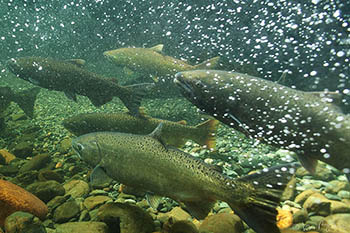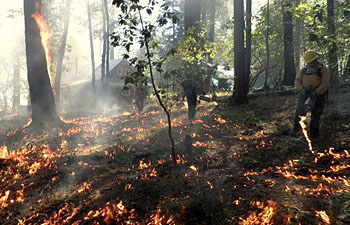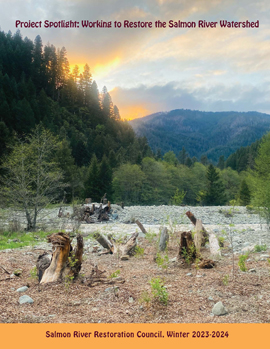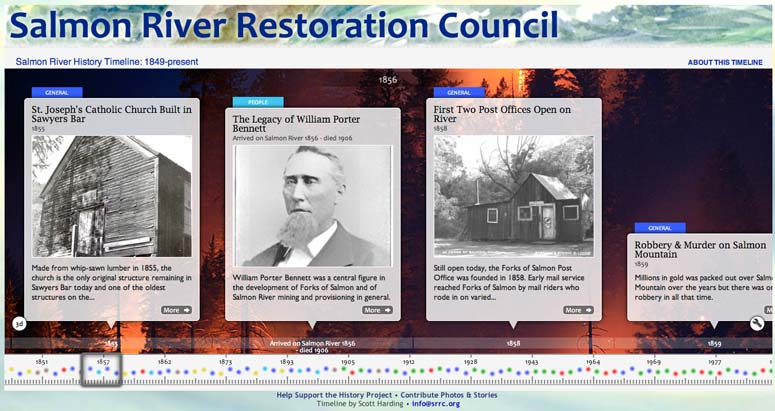Salmon River Restoration Council
2025 Salmon River Spring Chinook Dive Registration
Join us for the 2025 Salmon River Spring Chinook & Summer Steelhead Cooperative Fish Dive on July 29-30th, 2025.
Together, 80 trained divers will swim and count every spring Chinook and summer steelhead they can find in the Salmon River, its forks, and key tributaries. This fun event provides critical information on the health of the river's fishery and trends in salmon populations. Advance registration is required for all participants. The link to the registration form and additional information is available at srrc.org/fishdives. The official invitation letter can be found here.
Klamath Dam Removal Complete
On October 2nd, 2024 the removal of the four lower Klamath hydroelectric dams was completed!
Together, Copco No. 1, Copco No. 2, J.C. Boyle, and Iron Gate Dams had blocked fish passage and impaired water quality for more than a century. Following decades of advocacy, led by area tribes and supported by conservation advocates, commercial fishing organizations, and the States of California and Oregon, federal regulators approved the removal of the dams in November 2022. Ownership of the project was then transferred to the Klamath River Renewal Corporation (KRRC), the organization that was created to oversee the removal of the dams and related restoration of the previously submerged lands.
Copco No. 2, the smallest dam, was removed in the summer of 2023. In January of 2024 the Copco No. 1, JC Boyle, and Iron Gate reservoirs were drained, and deconstruction began in the spring. Massive amounts of concrete, earth, rocks and clay was removed from the river channel as part of the dam removal process. With these obstructions now cleared from the mainstem river, fish once again have access to more than 400 stream miles, including in tributary creeks and streams, of habitat in the upper Klamath Basin.
While the dam removal portion of the project is now complete, work will continue for several years restoring the 2,200 acres of formerly submerged lands. As the reservoirs drained in January, native seed mix was applied to the reservoir footprints. This initial round of seeding was intended to stabilize sediments and improve soil composition. This fall, restoration crews will turn their attention to amending soil conditions and will then perform another round of seeding and planting. Restoration crews will be onsite until vegetation success meets predetermined performance metrics. Restoration work is likely to continue for at least the next several years.
California Adds Northern CA Summer Steelhead and Spring Chinook to the Endangered Species List
 Salmon River Spring Chinookphoto by Michael Bravo
Salmon River Spring Chinookphoto by Michael BravoThe California Fish and Game Commission on June 16, 2021, found pursuant to California Fish and Game Code Section 2075.5, that the information contained in the petition to list northern California summer steelhead (Oncorhynchus mykiss) warrants adding NCSS to the list of endangered species under the California Endangered Species Act. Information has been posted to the Calif. Dept of Fish & Game commission's website and is available here.
On July 16, 2021 the California Fish and Game Commission voted unanimously to add Klamath Trinity spring Chinook salmon to the endangered species list! This listing is based on a petition that the Karuk Tribe and Salmon River Restoration Council submitted jointly in 2018, after continued decline of this critical salmon population.
This is a monumental win after decades of hard work by countless, dedicated people to get recognition and protection for our iconic spring Chinook salmon. We are immensely grateful to everyone who has been working to protect, honor, and restore these incredibly important and imperiled fish, their habitat, and the cultures and people who depend on them.
While it is hard in many ways to feel positive about a win that enshrines just how imperiled these fish are, we know that this is a significant step in preserving and restoring spring salmon. There is so much yet to do, but today we celebrate! You can read our press release here and the December 2021 Calif Fish & Game Commision Findings here.
Project Spotlight - Working to Restore the Salmon River Landscape.
The Winter 2023-2024 issue of our newsletter is devoted to highlighting some of the many individual projects that make up SRRC’s work. We hope you enjoy reading and learning more about what we’re actually doing out there when you see our staff wading creeks, flagging fuels reduction units, digging noxious weeds or managing heavy equipment operators. Most of our work is seasonal and as conditions change throughout the year, the work changes with them. Read about it here if you haven't seen it!
We've updated the newsletter viewer on our website and now all our newsletters display in full magazine-style format with flippable pages and searchable text. They are mobile-friendly and fully downloadable. All past newsletters are available in the Publications section.
The best way to receive our printed newsletters is to join SRRC as a member and we'll send them to you directly! Members also receive an annual report on Salmon River Restoration Council's work.
Past Spring Chinook & Steelhead Census Dive Results
2024 - The final numbers from the survey were 215 spring Chinook (206 adults, 9 jacks) and 209 summer steelhead (77 adults, 132 1/2 pounders). Numbers by reach are available here.
2023 - The final numbers from the survey were 241 spring Chinook (218 adults, 23 jacks) and 356 summer steelhead (271 adults, 85 1/2 pounders). Numbers by reach are available here.
2022 - The final numbers from the survey were 290 spring Chinook (271 adults, 19 jacks) and 387 summer steelhead (221 adults, 166 1/2 pounders). Numbers by reach are available here.
2021 - Another low year with 95 total spring Chinook (89 adults, 6 jacks) and 311 summer steelhead (168 adults, 143 1/2 pounders) The fish tally for 2021 is the second lowest on record since 1990, and marks the 7th year in a row that the total fish count has been below the long-term average. A full results by reach table can be found here.
2020 - Due to restrictions associated with the Covid-19 pandemic, we could not invite volunteers to participate in the dives. The number of spring Chinook counted, including jacks was 106. Summer steelhead numbers totaled 398 including half-pounders. A full results by reach table can be found here.
2019 - Sadly, the count of 161 spring Chinook (adults & jacks) observed during this year's effort is the second lowest in a record dating back to 1990. This makes 2019 the fifth year in a row with critically low population numbers. On a more positive note, the summer steelhead total (adults & 1/2 pounders) was 583, making 2019 the second highest on record. A full results by reach table can be found here.
2018 - 188 spring Chinook (168 adults and 20 jacks), and 411 summer steelhead (164 adults and 247 half pounders) were counted. One illegally poached adult spring Chinook was discovered in the South Fork Salmon River gorge below Cecilville. Please report any salmon fishing in the Salmon River system to CalTIP, the anti-poaching program led by the California Department of Fish and Wildlife (call 888-334-2258). One poached spring Chinook is the loss of nearly 1% of the entire population! The entire river system is closed to salmon fishing. A full results by reach table can be found here.
2017 - Unfortunately, despite the great water conditions, 2017's Salmon River Spring Chinook and Summer Steelhead Dive results were very low. Only 166 spring Chinook were counted (133 adults and 33 jacks), and 203 summer steelhead (68 adults and 135 half pounders). A full results by reach table can be found here.
Along with a handful of fish in the SF Trinity River, these fish are the last remaining wild spring Chinook salmon in the entire Klamath River watershed.
Study Reveals Evolutionary History of Imperiled Spring Chinook Salmon
A study published in August of 2017 in the journal Science Advances, uses new DNA analysis technology to identify the gene that makes spring Chinook salmon distinct from fall Chinook. This study, led by UC Davis, has major implications for the conservation of these unique fish. In the Klamath River watershed wild spring Chinook are on the brink of extinction, and this information has the potential to provide evidence necessary to have them differentiated from fall Chinook for management purposes. Based on the findings, the Karuk Tribe and the Salmon River Restoration Council began the process for petitioning to add the Klamath River's spring Chinook to the Endangered Species List.
Read the press release from UC Davis.
Salmon River Currents E-Newsletter Available
SRRC now has a monthly email newsletter that showcases the Salmon River watershed and our work. Every edition contains news and selected calendar events and will keep you in the flow of Salmon River activities and opportunities.
Read the Salmon River Currents and subscribe to get it in your inbox every month.
Also check out our seasonal newsletter devoted to noxious weed management in the watershed, The Weekly Weeder. See the archive for past issues of both our newsletters.
Seasonal Salmon River Wildfire Updates
See our Salmon River Flows, Weather, & Wildfire Info page for fire maps, links to these fires on Inciweb and social media, smoke information, and a live river webcam that is useful for a visual on smoke conditions. SRRC has recently installed a permanent smoke monitoring station in Forks of Salmon (see real-time data).
Prescribed Fire Operations with the TREX Program
This large-scale cooperative effort involves the Salmon River Restoration Council, Mid Klamath Watershed Council, Karuk Tribe, The Nature Conservancy, US Forest Service, CALFIRE, and many others. The goal is to train a local workforce in the safe implementation of prescribed fire, to raise awareness of the role of fire in the ecosystem and the benefits of prescribed fire treatments, and to accomplish a significant amount of prescribed burning in order to protect homes, communities, and natural resources as a step toward restoring the natural role of fire on the landscape.
 Prescribed burn around a local home, TREX 2014Photo: Lyra Cressey
Prescribed burn around a local home, TREX 2014Photo: Lyra CresseyThe TREX program is managed as a Type 3 incident and uses the same command structure and procedures that are used in wildfire incidents. This ensures a highly organized operation that is staffed by qualified professionals with experience managing both wildfire and prescribed fire. Each burn is conducted according to an approved plan, has all required permits, and the appropriate firefighting resources (fire trucks, water tenders, hand crews, etc.).
SRRC's Fire, Fuels, and Forestry Program is increasing its capacity and abilties in conducting prescribed burn operations and we expect to do more of this work in the future. Please contact us if you would like to learn more or are interested in prescribed fire on your Salmon River property.
Wildfire Map on SRRC Website
We had no large wildfires in the Salmon River watershed in 2015-2016 but 2017 made up for it. This earlier break in Salmon River fire activity gave us the time to put together a useful map that depicts wildfires, smoke dispersion, and other fire-related information for the area. You'll find this automatically-updated map on our Salmon River Flows, Weather, & Wildfires page.
SRRC Multimedia History Timeline on Website
Following our very popular newsletter that focused on Salmon River history, SRRC is pleased to announce the launch of a new multimedia history timeline on our website. The timeline features dozens of stories, hundreds of historical photos, audio, and video. Please check it out! This is an amazingly interesting trip through time.


Salmon River Restoration Council
PO Box 1089 | Sawyers Bar, CA | 96027
Salmon River (California)
530-462-4665
![]()

